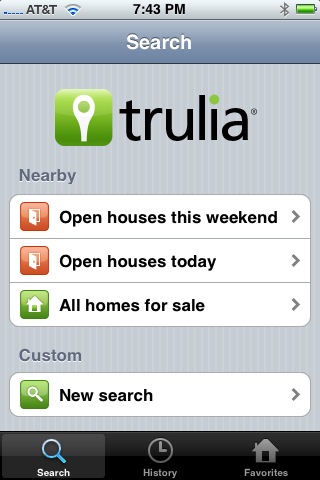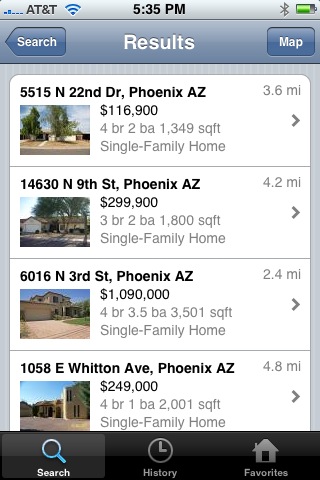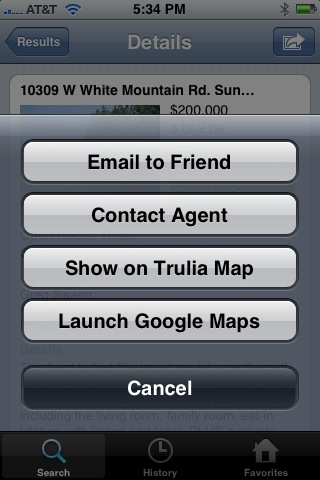Who’s winning the Realty.bot race, Trulia or Zillow? There is a constant flurry of new press releases from the two companies, but their boastful claims often sound like a pair of garrulous amputees agreeing with each other that the two-legged world is off its rocker: “Five million visitors! Ha-ha!” “A hundred thousand new listings! So there!”
Does any of this mean anything? There are wonderfully useful metrics for judging net.behavior. Unique visitors, for example. Pageviews per visit. Time on site. Even better: ROI per visit. But these measures are not independently verifiable, and the guides we do have available to us are inherently suspect.
So who is winning the Realty.bot race, Trulia or Zillow? Neither company has gone IPO. Neither company has gone belly-up. Beyond that, your guess is as good as anyone’s.
But: Tonight marks a decisive change in the game: Truila.com is releasing a fairly robust iPhone application as a part of a site-wide upgrade.
What’s new?
- Trulia Mobile will offer a limited set of location-based searches from Apple’s iPhone, from an array of Lightpole-enabled smartphones and from Dash Navigation GPS devices. The user-experience will differ by device, but the design premise is based on location-sensitivity: Your iPhone always knows where you are, so it can interact with Trulia’s file servers to show you a list of nearby listings or open houses. You can get a detailed summary for each home on your list, and you can then email the listing to a friend, contact the listing agent directly or map the home so that you can hop over for a quick peek.
- Trulia is adding a higher degree of user participation in the form of a new, free weblogging platform. Any registered user of the site will be able to start a blog.
- Finally, Trulia is offering greater personalization of the user experience in the form of a self-customizing home page. Your home page will reflect “new property listings, home prices changes, upcoming open houses, median sales price trends, recently sold properties,” all of these based on your past search history, along with “relevant blogs and Q&As from our Trulia Voices Community.”
In truth, personalization might turn out to mean more to ordinary consumers than to real estate professionals. My searches on Trulia or Zillow put me all over the map of Phoenix, and I can’t foresee that the software is going to be able to predict much about me.
The addition of free weblogging, on the other hand, is inspired. I told Zillow, when they installed their forum software, that what they really wanted were blogs. The reason is simple: Blogging creates a community of users with a shared interest in each other and therefore in the success of the weblog. The “owner” is there to tamp down bad behavior — an uncompensated de facto middle management layer — and each one of those owners has a long-term pecuniary interest in producing interesting content. Forums are beset by bad behavior, and the content is inherently evanescent. The differences in incentives between the two conversation models could not be more stark.
But either way, forums or weblogs, social-media tools are a very useful way to induce more users to visit more pages over more time-on-site, all of which serves to expose those users to more advertising. For selling ads, getting people to talk to each other is probably more profitable than getting them to look at listings of homes for sale.
This is Brian Brady’s bailiwick, but it’s easy to see how this can and should play out: The weblogs will connect to your user profile, but they will also link out every which way. For a real estate professional, your goal, without being obvious, should be to get interested consumers to click out to your home weblog or web site, where you can sell to them without the cacophony of nearby competitors. But to make that work, you’re going to have to add true value to Trulia’s site. This is a Brian Brady social-media marketing play to a fault.
What else is it? My bet is that this is a stake in the heart of ActiveRain.com. There has never been a good commercial reason for forty-bazillion Realtors to chatter to each other. Trulia is giving them an extremely EZ-2-Use weblogging platform with access to a claimed five million users a month. AR’s Localism would have been too little, too late anyway, but Trulia is already the hammer-of-the-gods on hyper-local long-tail search keywords. Points are points, but dollars are dollars. I’m thinking the Realtors who know the difference between points and dollars will migrate their blogging efforts to Trulia.
Incidentally, Trulia’s Heather Mirjahangir Fernandez tells me that links within blog posts — but not comments — will be followed by search engines. In other words, linking from your Trulia blog to your home weblog will pass SEO juice.
The big win of this release, of course, is the expansion of the Realty.bot game into the world of mobile computing. There are other mobile real estate applications out there already, but Trulia’s initial foray into this market seems inspired: If people are going to go out house-hunting on their own, whether they are really looking for a house or simply touring open houses for decorating ideas, why not use the location-sensing power of modern electronics to hook them into Trulia’s listings database, showing them what’s available near where they are and giving them details and driving directions so they can take a closer look.
I first heard about Trulia’s iPhone application on Thursday, when a BuinessWeek reporter called me for a reaction. I think maybe I was supposed to express fear and loathing, but I think this is a wonderful idea. I use Where to show me where the nearest Starbucks is when I’m out on the road. Why wouldn’t home-buyers want to use Trulia to find out which homes are for sale — for example — in neighborhoods closer to their jobs — or just in the neighborhood they happen to be driving through?
I personally would wish that the details page linked to the home’s web site — this since we build very elaborate single-property web sites. And the ability to contact the listing agent plausibly increases the likelihood of dual agency deals, but the fact of life is that many, many people are at least starting their home search without the advice of a buyer’s agent.
But here’s the immediate bonus that popped out at me when the reporter called: Listing agents who want to compete for mobile-empowered buyers need to get their listings into Trulia and they need to keep their open house schedules up to date. Anything that makes listers more diligent in their duties to their clients, I like.
Here are some screen shots from the iPhone application, which was released, running off of a demo server, on Friday:

This is the initial search screen. The app is built around the iPhone’s on-board GPS system, but you can use the Custom search to look at listings somewhere other than where you happen to be.

This is a location-based list of homes for sale. If you tap on a listing, you’ll go to the details screen.

Like this. This is one of our listings. You get baseball card details, the text description plus open house information and the listing agent’s contact information.

If you tap the outbound icon in the upper right corner of the details screen, you get these options — with “Contact Agent” being my particular favorite. This will launch the iPhone’s telephone software and dial the call. When you hang up, you’ll be right back on the details screen.
The user experience on Dash GPS systems and the other supported smartphones is going to be somewhat different. And since the smartphone application requires Lightpole, Palm OS phones like the Treo line of smartphones are not supported.
The software revolution being occasioned by the iPhone is fun to watch. In many ways it is reminiscent of the advent of the Apple II or the original IBM-PC: A vast glut of mostly useless toys — recipe files and DVD catalogs — thankfully mostly free. What’s going on is that programmers are teaching themselves a new software design paradigm, and they’re releasing everything they manage to finish, even though much of it is pretty stoopid.
That evaluation, at least, does not apply to Trulia’s push into mobile computing. The iPhone application is slick and useful as written, this because “data is the new Intel-inside” and Trulia has a rich store of data to draw upon. The usual caveats about opt-in versus MLS listings apply, along with concerns about decay among voluntarily-maintained listings. But, all that notwithstanding: Trulia’s mobile-computing initiative is cool.
Elsewhere: Mashable, My Tech Opinion, TruliaBlog, VentureBeat, BusinessWeek, TechCrunch.
Technorati Tags: blogging, disintermediation, real estate, real estate marketing, technology
James Boyer New Jersey says:
Ok the web war continues. Who will win ???? sounds like trulia has the upper hand for now but the long run has many challenges ahead. I am more concerned with how this will play out in the local search arena. If I started blogging on Trulia (who nips at my heals for my local searches) am I helping them more than I am helping myself??
August 25, 2008 — 8:40 am
Bob says:
A pretty slick move by Trulia, which should compel listing agent involvement over time.
The blogs may be the worst thing for Trulia, if the content is the same drivel regularly published on Active Rain. Trulia may regret giving voice to morons and then being directly associated with aforementioned moronic pablum.
August 25, 2008 — 9:21 am
Heather @ Trulia says:
@ James – you have three choices on Trulia Blogs. 1) use the Trulia Blogs platform to blog, build out your profile, write for a built in audience of home owners/buyers; 2) give Trulia an RSS feed of your existing blog = access to the same audience (functionality coming soon); 3) decide it’s not worth your while and do nothing.
We built Trulia Blogs after getting tons of agent feedback, so we hope you’ll opt for options 1 or 2. And, we’ll iterate along the way. Give it a shot – let us know what you think.
@Bob – Today we surface the most recent content, but increasingly we’ll let the community of consumers decide what the best stuff is and surface it. We agree – quality content rules.
August 25, 2008 — 9:58 am
Greg Swann says:
> give Trulia an RSS feed of your existing blog = access to the same audience (functionality coming soon)
Totally rocks. Off-the-charts smart.
August 25, 2008 — 10:08 am
Dave says:
@Bob,
The blogs may be the worst thing for Trulia, if the content is the same drivel regularly published on Active Rain. Trulia may regret giving voice to morons and then being directly associated with aforementioned moronic pablum.
So, you mean that we don’t need another blog about the pros and cons of holding open houses?
August 25, 2008 — 10:19 am
Michelle De says:
I am really, really excited – it makes what I paid to try out Trulia Pro much more valuable to me. Heather’s Option #2 absolutely rocks, now if I can just make time to figure it out.
August 25, 2008 — 10:35 am
Bob says:
@Dave,
I was thinking more about the post I saw about how to know that the number of AR posts you have is accurate (involves using a spreadsheet).
I’m sure we’ll see a tutorial about how to correctly answer a question on Trulia Voices, followed by the posts complaining about the answers on Trulia Voices.
I admire the forward thinking. I just feel for you having to deal with what we know lies ahead.
August 25, 2008 — 12:10 pm
JimAtJaxtr says:
Fascinating post. I’m also amazed at the innovation that’s spinning off around the iphone. It’s kind of become a catalyst for techie creativity. From a consumer’s standpoint, I love the idea of being able to find homes for sale in a given neighborhood directly from my phone, especially when I’m on the go and already over there in that neighborhood.
Since you’re into Web 2.0 stuff, I’m curious if you’ve heard of jaxtr.com. We’ve got a widget that lets you receive calls from your blog or site to your cell phone–it could be helpful for those real estate agents trying to better convert their traffic. Just thought I’d drop it in the conversation in case it piqued your interest.
August 25, 2008 — 12:44 pm
Cheryl Johnson says:
Speaking of moronic 🙂
@ Heather: I am looking at the Trulia “Manage My Blog” screen right now in another window. I don’t see any links to submit an RSS feed… Or are you expecting people to enter their blog feeds on the page for listing feeds ??
August 25, 2008 — 2:13 pm
Heather @ Trulia says:
@Cheryl – You might have missed it in my comment above, but the functionality to submit an RSS feed is “coming soon”.
With today’s launch, we wanted to roll out the core functionality. We’ll add other bells and whistles in the not too distant future!
August 25, 2008 — 4:40 pm
Tom Vanderwell says:
Not to start a blackberry vs. iphone debate, but I just downloaded it on my blackberry and it works. Pretty slick!
Tom
August 25, 2008 — 4:44 pm
Michelle De says:
Tom – that really excites me as ATT’s coverage in my area sucks and I am stuck with Verizon therefore a Blackberry! Thanks for taking the risk 🙂 I’m right behind you now!
August 25, 2008 — 5:42 pm
Cheryl Johnson says:
@Heather. Thanks. I did miss the “comming soon” part. 🙂
August 25, 2008 — 7:00 pm
Martin Bouma says:
A lot of good information, and some great comments!
August 26, 2008 — 6:50 am
Skinner says:
Very nice and informative post. Trulia seems to be winning but we should expect to see more competition and new features to get real estate information to the general public. I didn’t realize that Trulia has this feature, I am definitely going to research it.
November 30, 2008 — 4:31 pm